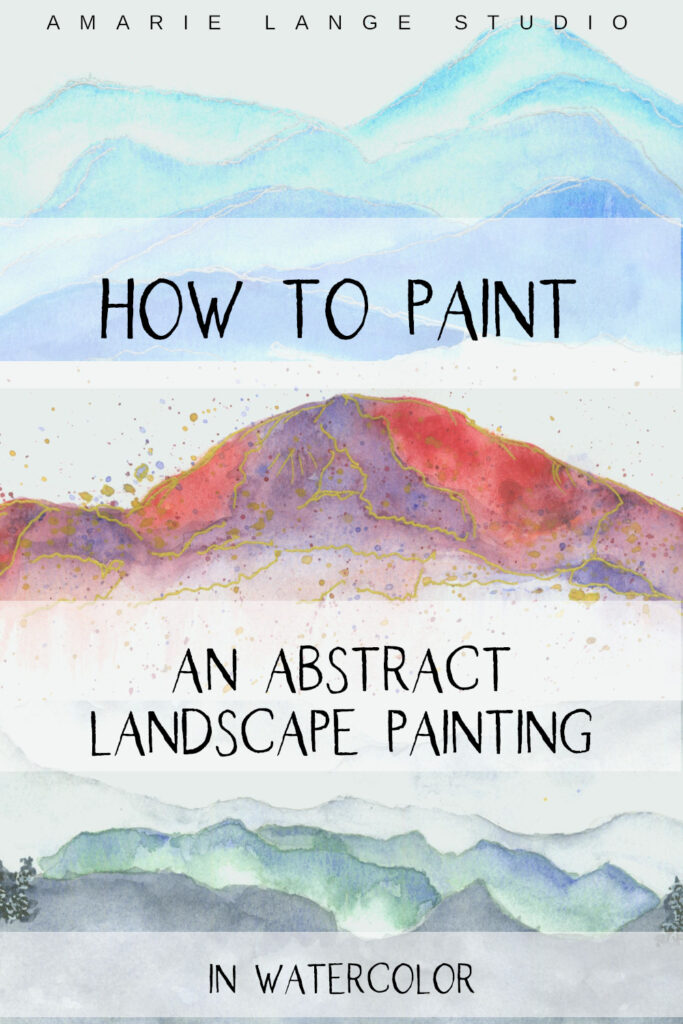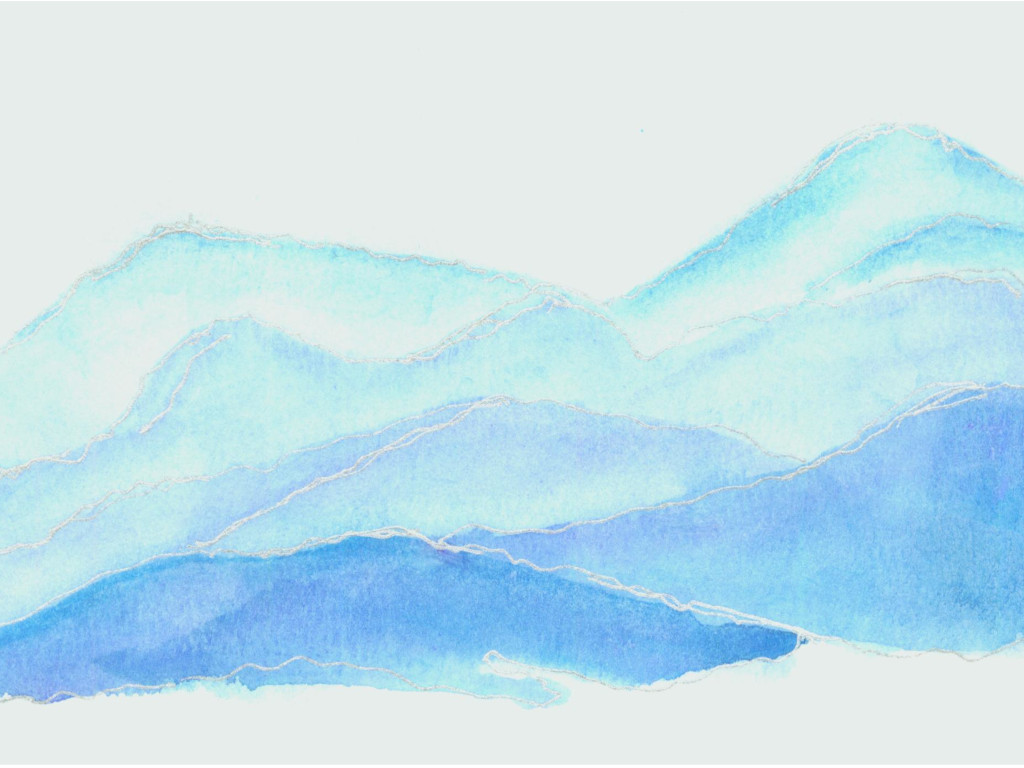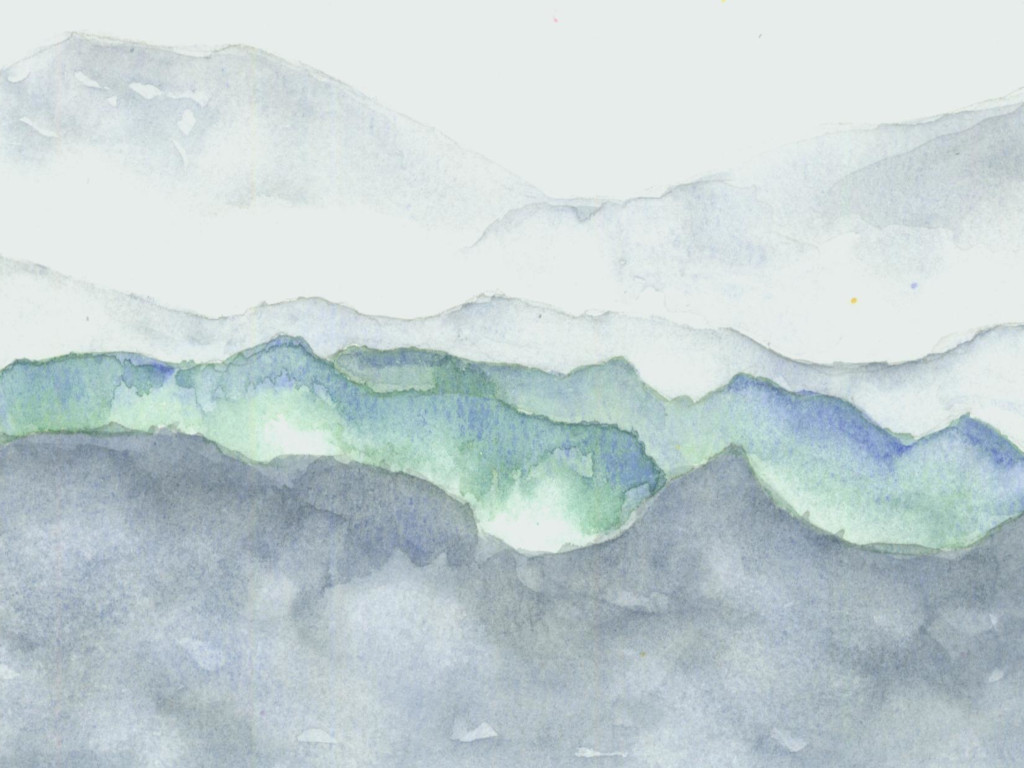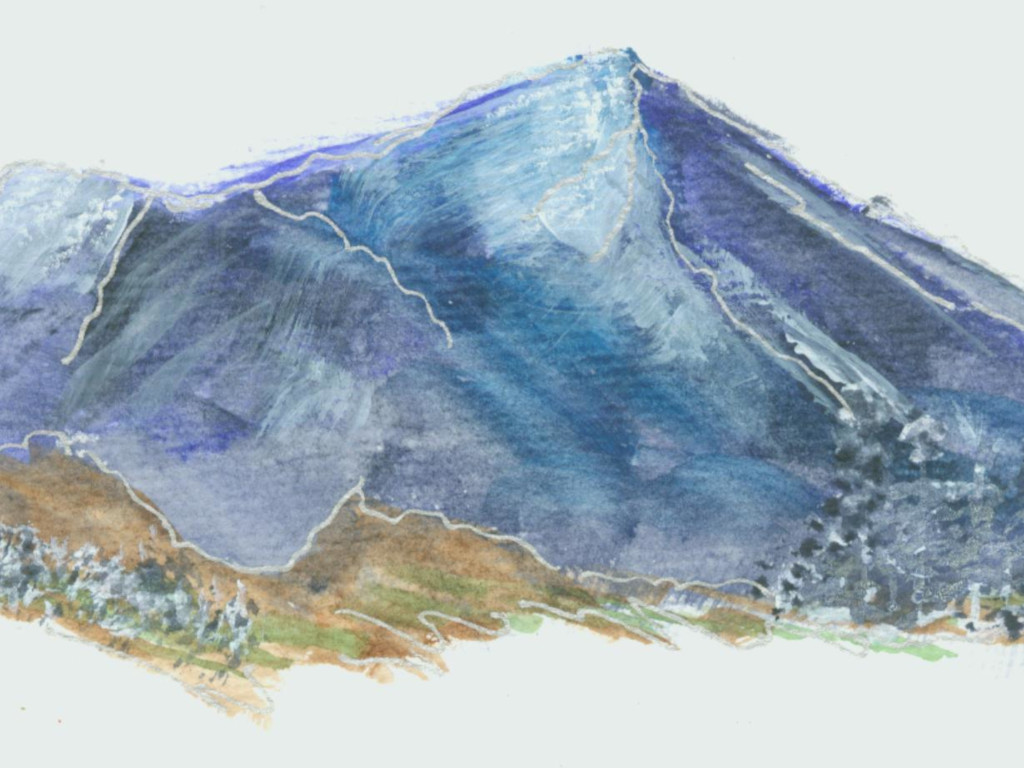Are you wanting to learn how to paint an abstract landscape painting? If you’re a beginner painter, these tips can help you practice abstract painting and create your own first abstract art.
I’m going to focus on how to paint abstract landscapes in watercolor using mountains in this post so you can see how changing up a single subject can give you lots of different results.
Let’s get started.

How Do You Paint a Landscape Abstract?
In the natural world, there are a lot of details.
In the abstract world, there are a lot of ideas.
It’s seeing with your creative eye, beyond your physical eyes.
At first, the process of creating original abstract landscape paintings – especially with watercolor – can be intimidating.
So I like to break down the painting process into steps. Giving you an easy way to get organized and a sturdy starting point for painting.
I’m going to show you several abstract watercolor mountain paintings to help you compare different techniques, the way layers of color impact your artwork, and different ways to create beautiful texture with watercolours.
Let me show you what I mean.
Watercolor Paints, Acrylic Painting or Oil Paints?
Lots of excellent abstract art is made with acrylics or oils. But if you’re reading this, you at least have an interest in making abstract painting with watercolors.
Nevertheless, if you want to see an easy tutorial for abstract acrylic mountains, this is a good one.
Focus on Geometric Shapes

Take a look at this fresh perspective of a mountain range.
I live in the mountains of Colorado in the US so there is plenty of beautiful subject matter right at hand.
I lightly sketched these mountains ranges first, to get the placement where I wanted it.
Then, using a fairly big brush, I loosely brushed in the big mountains to the back in a light blue wash. (I used ultramarine blue and coeruleum blue in this artwork.)
I wet down only where I wanted these mountains to go, not my entire watercolor paper.
Then I dropped in a light wash. Remember, you can always add more color but with watercolors it can difficult to lighten (although not impossible).
I let that section dry.
I then wet the next mountain range moving closer to the front. And added a similar light blue wash but slightly more pigmented.
The tendency here is to get too dark too fast. I’m creating a monochromatic color scheme in this artwork and the focal point is on the different blue hues, so it’s important I get each mountain range a little bit different.
I continue to move forward, one set of abstract mountains at a time, deepening the blues with each wash.
Then I go back over each mountain range, intensifying just the top portion of each mountain.
(Use your watercolor skills to make all kinds of helpful items like these encouragement cards)
It’s vital to keep the light/dark contrast between each mountain range so your eye can see how the color values change.
In an abstract work such as this, those subtle color palettes are the whole point.
To finish off this piece, I added simple silver pen accents.
Doing so really helps the artwork pop.
See how easy this is? You’ll definitely need to give yourself a few practice rounds, but abstract watercolor landscape painting is fun and quick to get started.
How Do You Paint a Loose Watercolor Abstract?

I really love this abstract mountains example.
Very loose, it seems to flow across the watercolor paper.
I gently sketched out what I wanted and again used a wet on wet technique.
Again, I did this section by section. That will keep this process much easier as you don’t have to work with an entire wet paper all at once.
I did tape this abstract landscape down before I got started. This piece has several layers of washes and because of all that water, it wanted to buckle – a lot.
Taping it down keeps the paper flatter to work with, helping you avoid huge water puddles while you work.
Again I started with the back mountains and moved forward – working slowly.
I kept adding washes over the previous layers as they dried. I also used a paper towel to gently blot up a bit of the watercolor in certain areas, such as where the mountain ranges meet. That helps to preserve the light/dark contrast and helps to make the top of each mountain really pop.
You have to be patient doing a watercolor abstract landscape such as this one. There is a lot of neutral color here but adding soft grays, then blue greens, then darker grays, I could achieve a beautiful effect; but it did take a long time.
(Use your skills to add abstract art to this free printable with a short Bible verse for strength and comfort.)
Watch your color temperatures. Here is a helpful article showing warm and cool color palettes. The linked article shows warm and cool colors charts together. I think it helps to see these charts side by side to get a clear understanding of the different feelings color temperatures give off.
This landscape abstract art gives off a feeling of moodiness, thanks to its cool color palette.
Also remember to let pieces of your white paper show through. Again, more contrast.
Go for Bold Abstract Watercolors

We’re still working on how to paint an abstract landscape painting in watercolor. But look how far we’ve come!
Just by exploring the same subject matter, in this case mountains, we can see the incredible variety of beautiful textures, geometric shapes and ground color we can use.
I started with another simple sketch. But this time went vibrant!
These watercolour abstract mountains are mostly red and purple, in varying hues.
This was again a wet on wet technique, but there’s only one mountain range to concern ourselves with this time.
If you’re using a reference photo, take a look at the valleys and peaks of your mountains and where the snow, if any, is laying.
These differences can be where you change colors on an abstract painting like this.
Really, you can paint whatever you want. This is just my idea of some eye-popping mountains.
On this piece, you can see that while my first layer of wash was still wet, I took a dry flat brush and gently pulled down some color.
The effect is subtle, but adds a whole different mood.
Then, when everything was dry, I added some paint spatters in the same colors and finished off with gold pen accents.
Make sure the pens you use with watercolors are waterproof; especially if you might be painting over them. That way the ink won’t smear and ruin your hard work.
Have you been painting with me? Give it a try! I know you can do this, too. And just the act of trying will show you so much more than I can tell you in a blog post.
Semi Abstract Landscaping Paintings with Watercolors

This mountain has a lot more detail than the first blue mountain. It’s more of a semi-abstract painting. There is still a lot of abstraction in it, however.
Again, start with a sketch and work this type of painting step by step.
This is a wet on dry watercolor technique, which means the watercolor paper was dry but the brush was wet when the paint was applied.
This allows for greater control and the ability to do a bit more detail work in your painting.
Just take it slow. Let the layers dry between layers of paint.
Keep in mind which way the sun is shining in your painting. Light sources are so important.
In this painting, I added simple abstract trees at the base. Those trees help to push the mountain back into the distance, anchoring it within the painting.
Unless you want to, you don’t have to worry about matching colors exactly with your reference photo.
Use the colors that look best to you.
I also added silver ink accents to this abstract painting. I love the way the ink defines the edges but doesn’t overpower the painting.
Try little extras like this yourself. You can also practice these ideas on a separate piece of watercolor paper before committing yourself on your final piece.
I try things out like that all the time!
Even Bolder Abstract Mountain Watercolor Painting

Not only did I create the mountain to be bold in this painting, I worked at making the sky bold as well.
You can certainly trace the mountain shapes from a reference photo if you like. Also remember there are lots of youtube videos you can learn from. I do that all the time, plus I use online art classes, such as Skillshare, as the best way to boost my painting and drawing skills regularly.
A bit of learning of a new technique significantly helps me create new, interesting textures and provides new vantage points from which to view my subject matter. And I experience a lot of freedom in my painting whenever I learn something new.
You’ll find your favorite places to learn, too. It’s an investment in yourself.
Well? Have you learned more about how to paint abstract landscapes in watercolor? Just a little bit? My goal when learning is to take away just one thing I can use to improve my painting. Just one thing! That really takes the pressure off and by studying abstract art and applying a little practice you may be surprised how good your paintings make you feel!
I certainly encourage you to paint often and joyously.
Take a look at these other abstract watercolor painting ideas – all beginner friendly with free tracing sketches included.
Always – keep painting!
